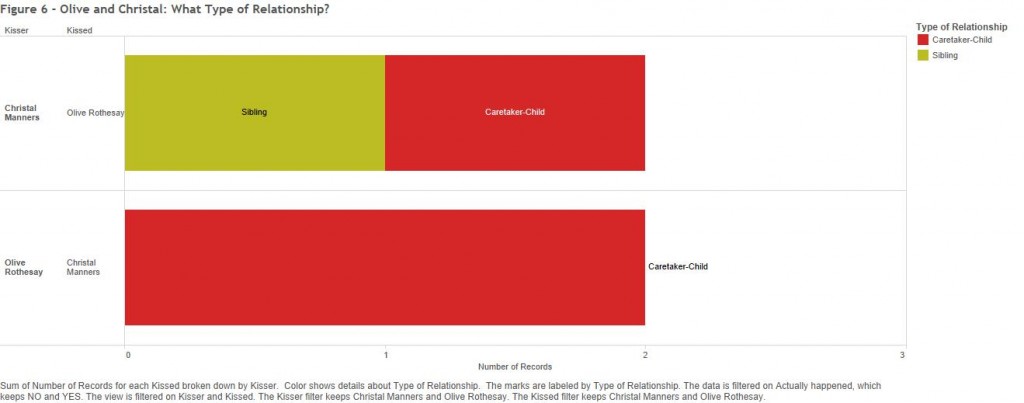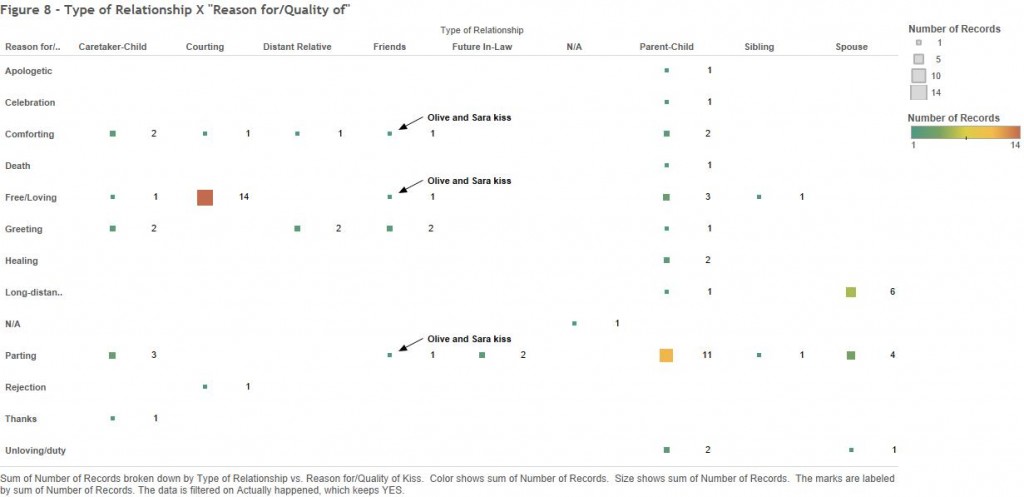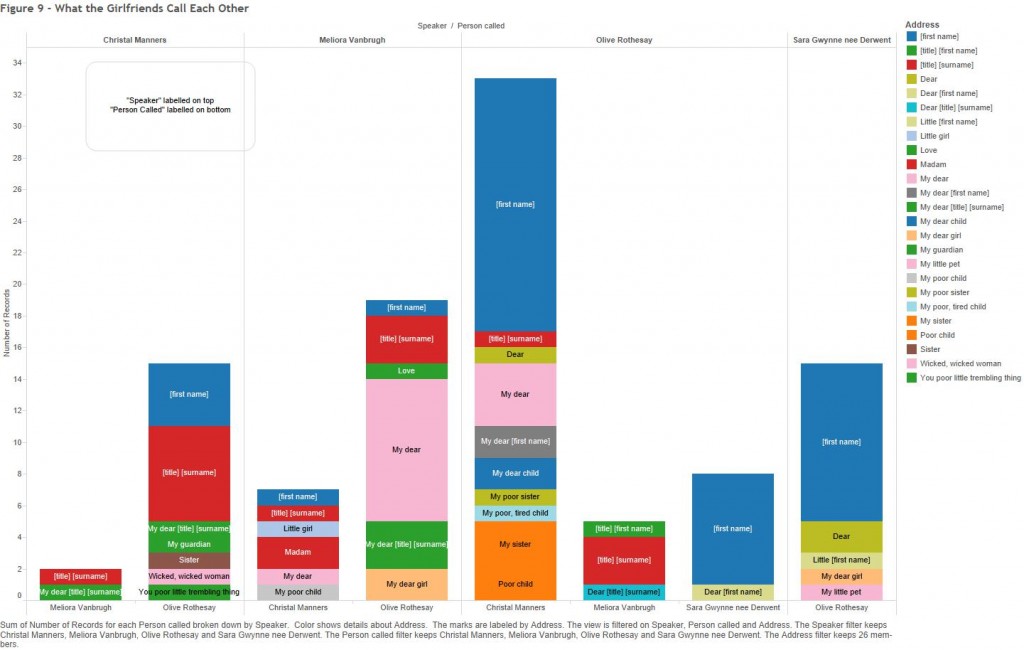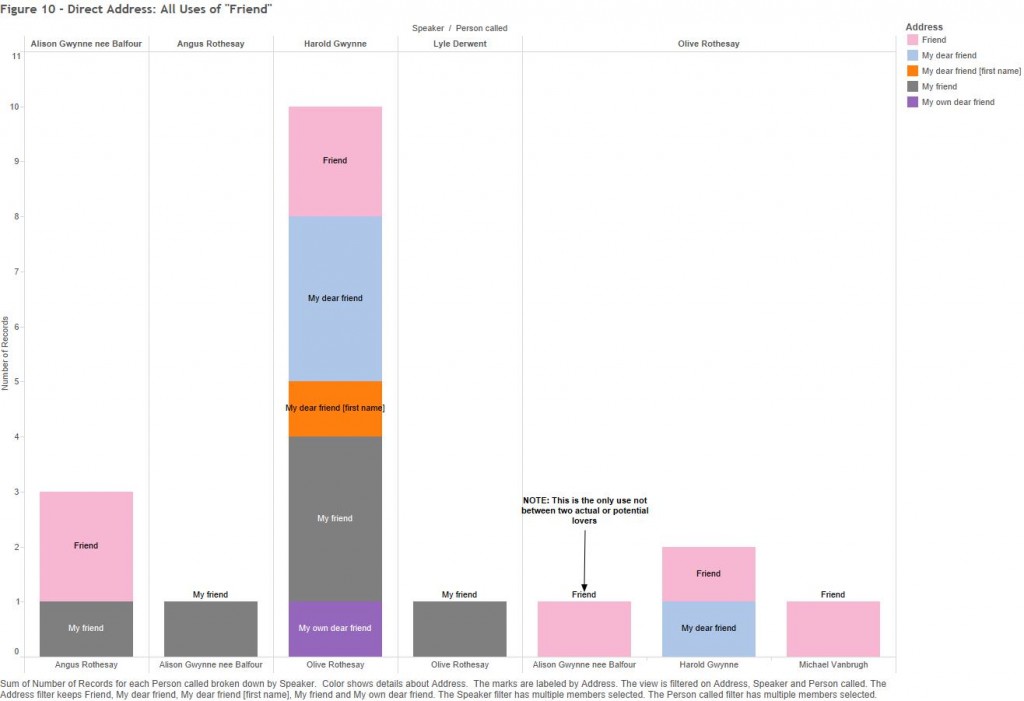Do the Kisses Queer Olive?
There is something queer about the relationship between Sara and Olive. Queer in that it is both unusual and has homosexual overtones.[1] A close reading and a class discussion (Bourrier ENG 607 class notes) revealed the latter point, particularly in the narrator’s insistence that female first-friends, like Olive and Sara, share many qualities with “first loves”; “fore-shadowing” those later relationships (chap 11).[2] The kiss data supports the notion that there is something queer, meaning unusual, about Olive’s relationship to Sara, but it is less definitive on the homosexual reading, as the data can also support the possibility that the girls behave as siblings.
In total, the kisses in Olive support notions of heteronormativity, thus making Olive and Sara’s kisses an unusual case. Figures 1 and 2 show that while female-to-female kisses seem to form the majority of those in the novel, kisses between males and females are more frequent, only split based on which gender is kisser and which is kissed.
By filtering out the familial relationships (types: “parent-child”, “sibling”, “future in-law”, “distant relative”, and “caretaker-child”) – leaving only the “courting”, “spouse” and “friends” kisses – shows that, in terms of friendship or romantic/sexual love, the female-to-female kisses in Olive form a tiny minority (fig 3).
The blue wedge shows the kisses of two “friendships”: two cheek kisses between Marion M’Gillivray and Sister Ignatia (chap 38; fig 3), and three kisses on-the-lips between Olive and Sara. Looking at what body parts are kissed in the heterosexual courting and spouse relationships (as shown by the labels in fig 3) seems to show Olive and Sara having more in common with lovers than with friends. Like the girls, the heterosexual couples also kiss on the lips, but not on the cheeks, like the other pair of “girlfriends”. The kiss data at least supports the idea that Olive and Sara share a unique friendship in the novel; after all, Olive never shares a kiss with her other friend, Meliora Vanbrugh (fig 4).
So, there seems to be something queer, in the homosexual sense, in this friendship, but a more general look into the “friendship” kisses of Olive hints at another reading: Olive and Sara behave as sisters. Figures 4 and 5 compare all the kisses one could construe as being between two female friends, even though the “type of relationship” label says otherwise.[3] Thus we can compare the Olive-and-Sara kisses with those of Olive-and-Christal, Christal-and Meliora, and so forth. Furthermore, the “Actually Happened?” filter allowed in the NOs to definitively show that a kiss between Meliora and Olive was not even imagined or requested by a character.
From these two graphs, it appears that the Olive-and-Sara kisses share the most similarities with the Christal-and-Olive kisses. Both couples share “parting”, “free/loving” and “comforting” kisses, unlike any of the other “girlfriends” (fig 4). Additionally, Olive shares on-the-lips kisses with both girls; no other girlfriend-couple does so (fig 5). The problem is that Christal and Olive are, arguably, not friends. Figure 6 shows the “type of relationship” labels for all the kisses between Olive and Christal.
They are “siblings” only once Olive and the reader explicitly know that information (chap 41).[4] Earlier Olive takes on a caretaker role regarding Christal,[5] for example, by handling Christal’s finances (see the horse discussion, chap 28).[6] In both stages Olive seems to be the “big sister”. If one looks at Figure 4 again within this light, one can see that “big sister” Olive gives a comforting kiss to Christal, whereas “little sister” Christal kisses with a “free/loving” quality. Turning to Olive and Sara, it seems that Sara is the comforting “big sister” and Olive is the “free/loving” younger sibling. The “reason for/quality of” descriptions of the kisses seem to reveal what kind of relationship this is, and what role each participant occupies.
So far the kiss data has offered some evidence pointing to homosexual undertones and sisterly qualities in the Olive-Sara relationship. However, neither case is definitive; perhaps requiring supplemental evidence looking at another aspect, such as what the girls call each other. The arguments presented so far must deal with the fact that the kisses between Sara and Olive could indicate both a romantic/sexual and a familial relationship, shown by widening the kiss data to all of the kisses that actually occur in the novel. Lip-to-lip kisses occur in both relationship types (fig 7, second-bottom row), as do “comforting” and “free/loving” kisses (fig 8, third and fifth rows).
With the goal of pinning down what kind of relationship Sara and Olive have, let us, briefly, look at another set of quantitative data: direct addresses.[7] Figure 9, much like figures 4 and 5 above, just compares the data for those female characters who could be considered “friends”. The data is further limited to just those who are friends with Olive.
Olive and Sara call each other most often by the first name; Olive does likewise towards Christal, but Christal keeps things more formal, using Miss Rothesay ([title] [surname]). Contrariwise, looking at Meliora and Olive, who are friends, shows a comparative lack of first name use (fig 9). In the text, Olive and the narrator make a big deal about calling Harold by his first name (chap 47)[8] and about getting called “Olive” by Harold – it causes her heart to leap (chap 36) – and by Harold’s mother (chap 33). As such, it seems that greater intimacy comes with the first name; thus perhaps supporting a queer (homosexual) reading of Olive and Sara, provided one can explain Olive’s use of “Christal” in her caretaker or sisterly role.[9]
Similarly, the appellation “friend” – which Olive and Christal never call each other – becomes a relationship test; though ironically “friend” is not used by female friends (fig 10). The data on the use of “friend” actually provides evidence against the homosexual undercurrents between Olive and Sara. “Friend” is almost solely used between characters who, at some point in the novel, show the desire for romance, marriage or sex.[10]
Angus and Alison Gwynne call each other “friend”, Harold and Olive do likewise; and the two other men who propose to Olive either call her “friend” or are called that by her. None of the book’s same-sex friends use the term; the direct address “friend” is almost completely limited to potential, or actual, lovers. Thus it seems a queer reading of Olive, while still possible, has one more hurdle to jump. Perhaps Sara and Olive are acting like sisters.
The kiss data of Olive shows kisses between Olive and Sara to be unusual for female friends in the novel. Some of the evidence supports a queer reading, some points to Sara and Olive treating each other as sisters. Perhaps, in truth, their relationship is a little of both. The supplemental evidence from the direct address data perhaps points to a kind of intimacy or familiarity between the girls, but it also offers a road-block to reading Olive as having homosexual feelings towards Sara. A close reading of Craik’s novel does show there to be an unusual, and possibly homosexual, element in this “friendship”, particularly on Olive’s side, but the kissing data alone does not definitively show exactly how the relationship is queer.
Endnotes
[1] Though only the former meaning would be understood in Craik’s time, as the “homosexual” definition of queer only dates from the 1910s (“queer adj.1”).
[2] All quotations from Olive are from the 1875 edition of the novel, as found on the Project Gutenberg website, as this was the text I used for the collection of the data. Unfortunately, that means there are no page numbers, thus chapters are cited.
[3] Thus, in addition to testing the theory with the kiss data, perhaps we are also seeing some of the limits to the categorisations.
[4] The kiss labeled thusly happens in chapter 49; so Christal knows the truth too.
[5] First with Meliora, and later alone.
[6] The dying Sybilla even charges Olive to “take care” of Christal (chap 32).
[7] This data comes from my counting of the approximately 950 direct addresses in Olive – with “Direct Address” simply meaning what Person A calls Person B when, and only when, talking to Person B. What person A calls Person B when talking to Person C is not counted. The data was collected with strict rules, most similar to the kissing data, or analogous to it. There is not enough space here to get into all the details.
[8] See also “For of late—perhaps with more frequently hearing him called by the familiar home appellation, she had thought of him less as Mr. Gwynne than as Harold” (chap 33, emphasis in original).
[9] The data also show many uses of first names between family members, parents to children for example; so the use of first names is not solely indicative of a romantic/sexual relationship. Olive calling Christal by her first name is just one example.
[10] The one exception is the single instance of Olive calling Alison Gwynne “friend”.
Works Cited
Bourrier, Karen. ENG 607 L01. University of Calgary. Winter 2015. Class discussion notes.
Craik, Dinah Maria. Olive. London: Macmillan, 1875. Project Gutenberg. 24 Oct. 2012. Web. 12 Mar. 2015.
“queer, adj.1.” OED Online. Oxford University Press, March 2015. Web. 14 Apr. 2015.

The Kisses of Dinah Mulock Craik’s Olive by Aaron Ellsworth is licensed under a Creative Commons Attribution-NonCommercial-ShareAlike 4.0 International License.
![Figure 1 - Gender Mix [Kisser-Kissed]](http://aaronellsworth.ca/wp-content/uploads/2015/04/B-Figure-1-Gender-Mix-Kisser-Kissed-1024x544.jpg)
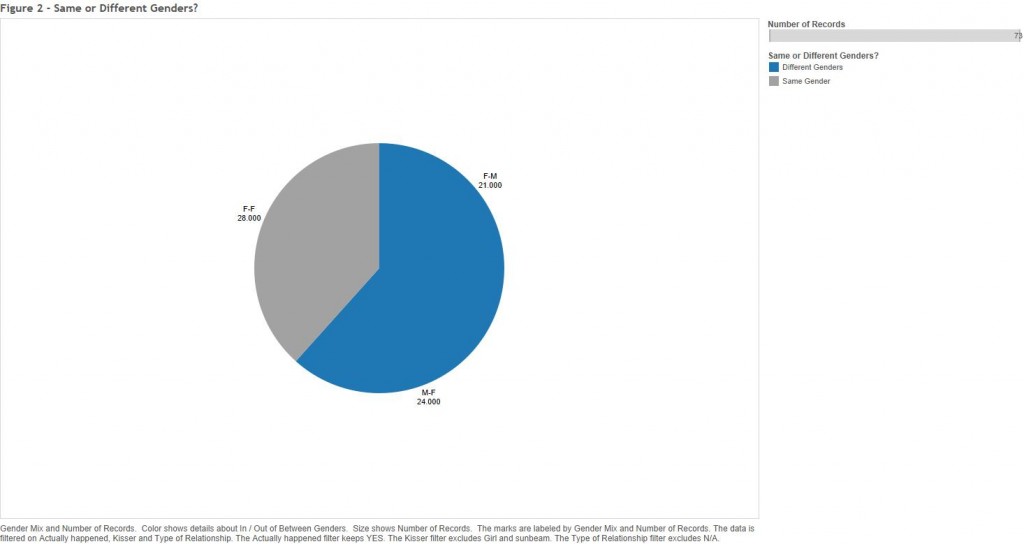

![Figure 4 - Female Friendships [Reason for/Quality of]](http://aaronellsworth.ca/wp-content/uploads/2015/04/B-Figure-4-Female-Friendships-Reason-forQuality-of.jpg)
![Figure 5 - Female Friendships [Body Part]](http://aaronellsworth.ca/wp-content/uploads/2015/04/B-Figure-5-Female-Friendships-Body-Part.jpg)
